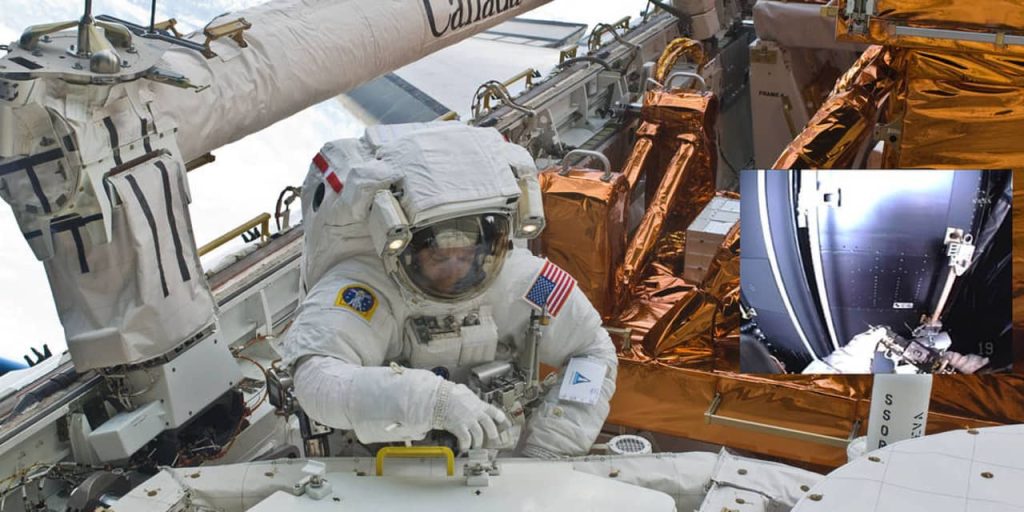We can all relate to the frustration of trying to remove a stripped screw, but, for Mike Massimino, one particular mangled screw was higher stakes than your typical DIY headache.
In 2009, the then-astronaut was in space, floating next to the body of the Hubble Space Telescope and struggling to remove one of the screws that fastened a handrail to one of the telescope’s instrument panels.
Massimino was working to replace the power supply to Hubble Space Telescope Imaging Spectrograph, one of its most important scientific instruments. Floating high above the Earth, a handrail needed to come off before Massimino could remove another 111 screws and get to the instrument panel.
“The easiest task was going to be removal of a handrail,” Massimino told MarketWatch, noting that the power supply replacement was the most complicated repair ever attempted on the Hubble Space Telescope. “100 new tools were designed for this task,” he added. While the first three screws that attached the handrail came out easily, Massimino ran into a problem on the fourth and final screw — he had stripped it with his power tool and now it wouldn’t budge.
Related: Virgin Galactic’s stock continues tumble following Morgan Stanley downgrade
Massimino tried different bits, but nothing would work. His fellow crewmembers on the space shuttle were also working with NASA’s Johnson Space Center in Houston to try and solve the problem. Eventually, a team at NASA’s Goddard Space Flight Center in Maryland came up with a solution – rip off the handrail. This, however, was not without its risks, such as potentially puncturing Massimino’s spacesuit, or sending debris flying that could damage the space telescope.
“They had me tape the bottom of the handrail,” Massimino told MarketWatch. After giving the handrail “a couple of shakes” the astronaut then successfully yanked it away from the side of Hubble. “It came off, no problem,” he said, and there was no debris.
Massimino’s tales are part of his latest book “Moonshot – A NASA Astronaut’s Guide to Achieving the Impossible,” which is out on Dec. 5th.
“Get help, don’t shut down,” he told MarketWatch, explaining that his time working at NASA taught him important lessons about teamwork, leadership, speaking out, and also reaching out for help.
Read next: SpaceX’s Super Heavy Rocket explodes in dramatic second Starship flight test
Born in 1962, Massimino grew up in what he described as a “working-class neighborhood” in Franklin Square, Long Island. The Columbia University and MIT graduate was selected as a NASA astronaut candidate in May 1996 and flew aboard Columbia and Atlantis Space Shuttle in 2002 and 2009. He completed four spacewalks during those missions, lasting a total of 30 hours and 4 minutes. Massimino left NASA in 2014 and is now a professor of mechanical engineering at Columbia.
Massimino learned important leadership lessons from Apollo 12 astronaut Alan Bean, the fourth man to walk on the moon. “He told me that the key to being a good leader and teammate is to find a way to care for and admire everyone on your team,” Massimino said. “I heard it from him, probably, when I had been an astronaut for nine months — he came to talk to our astronaut class.”
One of the chapters in Massimino’s book is devoted to “pivoting,” with an explanation of Bean’s pivot to painting after 18 years as an astronaut.
Related: United Launch Alliance eyes first Vulcan rocket launch later this year
The book also addresses mistakes, and how to cope with them. “You’re going to make mistakes, you have got to learn how to deal with them,” Massimino told MarketWatch, recounting an incident when he cracked the visor on his helmet while training in a NASA pool. “I was moving too quickly — they had to pull me out of the water to inspect [the visor]. I was so embarrassed,” he said. “I was told: ‘You know, man, you made that mistake, but you have to let it go – you have the whole game in front of you.’”
At NASA, Massimino and his colleagues had a technique for overcoming the feelings that follow a mistake. “We had the 30-second rule — 30 seconds of regret and then move on,” he said.
With regard to change, the astronaut saw the advent of private space companies towards the end of his space career. Almost 10 years later, the likes of SpaceX, Blue Origin, Axiom Space and Virgin Galactic Holdings Inc.
SPCE,
+3.77%,
are reshaping the space industry, along with United Launch Alliance, which is a joint venture between Boeing Co.
BA,
+0.93%
and Lockheed Martin Corp.
LMT,
-0.73%.
“It gives more opportunity for people … what we’re looking at for the future is very promising,” Massimino said.
As an example, the professor explained how his students at Columbia have been able to send two research projects to space — one on a Blue Origin vehicle, and another that traveled to and from the International Space Station via SpaceX.
Podcast: The future of space exploration
Read the full article here




